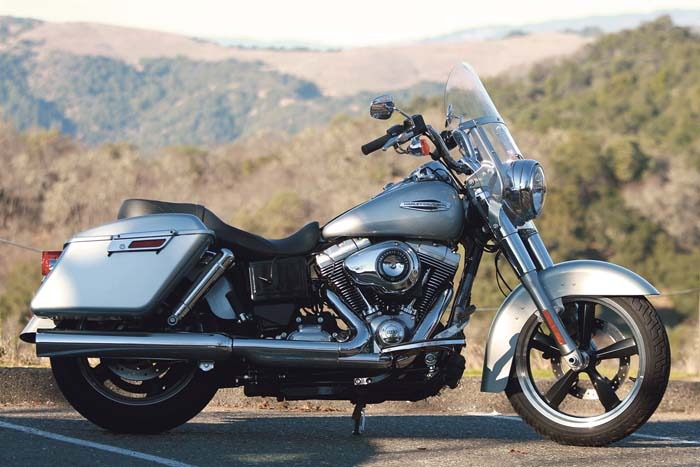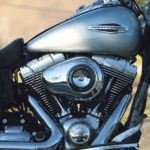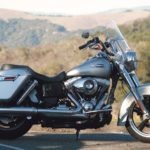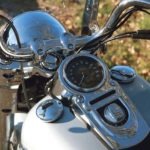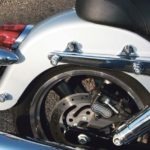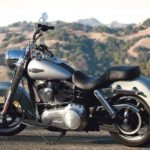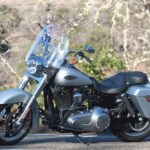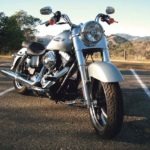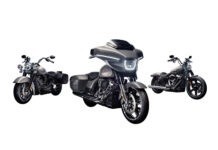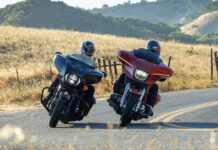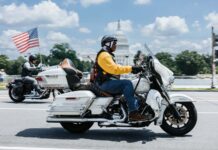Ever since the unveiling of the new FLD Switchback last summer, the universal impulse has been to compare it to something else. The most widespread comparison has understandably been to the Road King, Harley’s long-running minimalist touring model which with its stock windscreen and hard saddlebags was just begging for it. Within nanoseconds of the model’s appearance the obvious and unfortunate sobriquet of “Road Queen” was in play, and it’s not like The Motor Company wasn’t complicit in all of this, heralding the bike as lighter, less intimidating, and less costly than the Road King, and thus essentially a downsized low-budget version of a for-real Harley bagger.
Spend a few days on the road with the Switchback, however, and that impulse to see it as what it isn’t instead of what it is vanishes, and the realization that the Switchback is absolutely unique and complete unto itself replaces it. That epiphany struck me the second morning out as I walked out of my motel room in Paso Robles to pack the bike for another day in the saddle, and seeing the machine with a fresh mind at first light I saw it in—appropriately enough—a new light. It was no longer the sum of its parts—the culmination of a long list of engineering challenges and balancing acts—or a savvy marketing exercise, or a downsized anything. It was just a perfectly-proportioned, beautifully-executed specimen of serious Milwaukee road iron.
The designers didn’t set out to create a downsized Road King, though there’s no denying that model’s influence as a template for the first FL treatment of a Dyna. Rather, the Big Idea here was to revive the “convertible” concept in more contemporary and dressier trim. It had been a dozen years since the last OE foray into the multi-purpose format, and it took that long to revisit it because the predecessors enjoyed lackluster reception at best from consumers who, at the time, were more interested in glitz than utility. Times have changed in that regard as value is more of a virtue now, and the success of the CVO Convertible helped too. But most importantly, Milwaukee’s re-envisioning of the convertible concept in the case of the Switchback expanded the scope to add some the of the glitz missing in past efforts and thus set out to produce a machine that could pass as a stylish cruiser, back road campaigner, and super-slab horizon chaser with solid competence in all three of those pursuits.
A tall order, that. But no one ever said that doing the impossible would be easy. Achieving all of those ends in a balanced package that’s not just highly functional but also easy on the eyes required a holistic engineering approach as ambitious as any The Motor Company has undertaken. Every styling, handling and touring element of the bike had to be considered in light of every other element simultaneously in a sort of three-dimensional chess game. It required maximizing the model’s abilities in each of its three assigned operational roles without detracting from its chops in the other two.
For example, the styling directive demanded a bold FL-style front end while the back road mode needed low weight and quick handling manners and the touring persona asked for all-day pavement-seam absorbing compliance. It was like juggling a bowling ball, a Bowie and a balloon. And they pulled it off neatly.
The solution they arrived at included a clean-sheet redesign of the familiar FL fork covers and nacelle using chromed cast aluminum (a feat in itself) instead of zinc, a revised rake/trail formula, a purpose-designed low-profile 130/70B18 Dunlop tire on a lightweight cast-aluminum wheel, and a front suspension that employs triple-rate springs and cartridge damper technology to provide long-mile cushioning but stiffens up for the rigors of aggressive cornering. But the cartridge is only in one fork tube in the interest of shaving weight. The other tube houses a conventional rod damper. And my eyes just crossed.
On the backend of things, new “cigar case” emulsion rear shocks have been employed that offer five levels of spring preload and look just super on the machine.
Similar agonizing went into the design of the touring amenities where it was the styling and touring camps that were at engineering loggerheads. While the windscreen was a no-brainer since Harley had long since perfected the art of the quick-detach unit in that department, the saddlebags had to be designed completely from scratch.
For the sake of aesthetics and orthodoxy they had to retain the basic shape of traditional FLT panniers, but also detach deftly without leaving unsightly mounting hardware behind to detract from the bike’s street panache. Furthermore, they needed to mount snug to the fender to maintain the model’s lean lines. Taking a page from the CVO Convertible’s playbook, an unobtrusive three-point docking post setup was designed, with two docks on the fender strut and one on the lower fender surface. It’s a snappy arrangement, literally, with a knob inside the bag that locks and unlocks the attachment with a twist. The bags slip on and off with ease.
The toughest challenge in fashioning the new saddlebags were the lids. With little space between them and the fender, existing latch mechanisms couldn’t be used, and a new setup was devised. It’s similar both in appearance and operation to the existing units, but uses a very thin pair of latch catches on the bag’s back side. Done properly, the closing and latching of the lid securely can be a one-hand operation… done properly. Unfortunately, it’s all too easy to do it improperly and hook just one of the catches. The lid then doesn’t seal and can pop open when jarred by a bump in the road. Getting it right takes some practice.
The new saddlebags are about 25 percent smaller than those on the Touring models, but as a practical matter are plenty spacious enough for solo multi-day outings when augmented with a small pack or duffle on the passenger pillion. For two-up duty, you’ll want to invest in Harley P&A’s quick-detach suite of add-ons—a passenger backrest and luggage rack—and a big sissy bar pack (a T-Bag or equivalent).
The Switchback’s ergonomics strike an optimal balance in accommodating riders of a wide range of sizes. The low 27″ seat height and Dyna-dimension distance to the handlebar and footboards favor those of a smaller stature, but thanks in large part to the foot placement possibilities of the those footboards (and the absence of an obstructive heel shifter, happily), tall operators like my 6′ 4″ self have no trouble finding their sweet spot.
The windscreen’s another effective balancing act, well-proportioned for the machine visually, and rising to a height below the sight line of the rider. Even at that relatively low height, its proximity to the operator makes for a fine fair-air bubble and ample protection from the wind and weather. That effectiveness coupled with the comfort of the seat and free-range footboards make 500-mile days not just bearable but pleasurable. After a 530-mile run in eight and a half hours my long bones and caprine cakes (i.e., “goat ass”) were feeling just dandy and ready for more, thank you very much.
The Switchback’s companionable personality has a distinct wild side owing to the Twin Cam 103 motor that came to most of the Dyna platforms for 2012 (all but the frugal-minded Dyna Superglide and Street Bob models). Now in its third year of OE usage, the TC103 has proven itself a reliable, potent and economical unit in all applications. It’s a lusty brute, producing a claimed 100 pounds of torque, and the power pours on with arm-straightening abandon throughout its range. Mated to the Switchback’s relatively light 718 lb. weight, relatively short 62.8-inch wheelbase and relatively tight 29.8 degree fork angle, it results in a seriously light front tire when you grab a fistful; freeway onramps are a guilty pleasure, and quick spurts of maneuvering power in dicey urban traffic are but a flick away.
The power/weight ration also makes 6th speed a reasonable selection for motoring along at pretty much any speed over 60 mph with a cellarful of seamless thrust on tap. Loping along at 75 mph, the motor spins at about 2,700 rpm. For Interstate work, it’s a set it and forget it proposition.
Adding to the TC103’s lovable attributes and also burnishing the Switchback’s bagger styling credentials is another clean-sheet component, the 2-into-1 exhaust system. Creating such a system was a priority of the model’s designers, though it may have seemed at times a rash decision considering the lengths they had to go to in order to make it happen. The routing of the headers and the mounting of the collector required both a new transmission case in order to attach it securely and the relocation of the oil-fill bung. Both visually and aurally the new setup was worth the trouble. It’s not only a handsome system that complements the cigar-tube rear shocks and the cut of the saddlebags, it also emits a truly gnarly growl under power.
Harley-Davidson summed up the primary nutshell directive of the new Switchback in saying, “It’s all about handling,” and that claim was what needed further exploration when I departed Paso Robles for a second day of test riding. I rode over the mountain at San Ardo to the intersection of routes 198 and 25. The 63-mile run on route 25 from there to Hollister is my favorite back-road test track, offering, as it does, a veritable gallimaufry (i.e., “goat ass”—no, wait. I mean “confused medley”) of sweepers and twisties—banked, flat and off-camber—in addition to full-spank unpatrolled straight-a-ways ending in abrupt pairs of right-angle pucker-string-pulling turns. Whee… Ulp.
The Switchback attacks the course confidently, taking steering inputs like a cutting horse, displaying generous cornering clearance, lunging off the apex like a goosed cheetah and streaking down the straights like a Geico piggy. They should put pinwheels on this thing.
When Harley-Davidson introduced the FLD Dyna Switchback to the press last summer, they announced that the model was targeted at “Core young/Older Gen X (35-45), women, and Boomerangs (aging Baby Boomers).” That targeting covered a whole lot of demographic territory and ran the risk of running afoul of the conventional wisdom that in trying to please everyone you’ll end up pleasing no one—or worse, in the case of a motorcycle, you’ll end up boring everyone. That’s not the case with the Switchback, however—not by a long shot. On the contrary, this model hits all the right notes; makes all the right moves. Fast, nimble, and nicely outfitted for highway adventure, it’s inarguably the most well-rounded and exhilarating Milwaukee bagger to date.
Road Queen? My sweet caprine cakes. More like Road Warrior.
The 2012 FLD Dyna Switchback is available in Ember Red, Brilliant Silver and Vivid Black, with an attractive starting price of $15,999.


